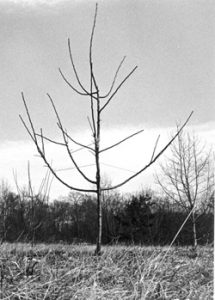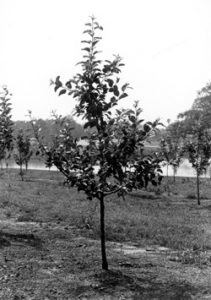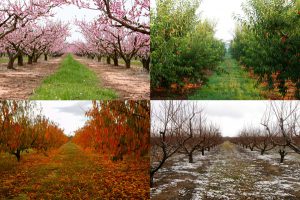If’ you’ve been putting off pruning that overgrown pear tree until the perfect moment, well I’m here to tell you that moment has finally arrived! Late winter is the best time to prune as plants are dormant and can definitely handle a much needed “haircut”, if you will. However, not all fruit trees like to be pruned equally: each family of trees has a specific form that you should stick to in order to minimize branch breakage and disease while maximizing yield.
Apples and pears should be trained and pruned with a “central leader.” This means they almost have a Christmas tree shape. There should be one obvious central line, and the branches should become shorter and shorter farther up the tree. As a general rule, you want to take away one third of a tree’s volume every year to ensure plenty of airflow and decrease splitting and rubbing. When looking at your tree and deciding what branches to remove first, remember the three D’s: Damaged, Diseased, and Dead. Dead wood can be easily seen over the summer as bare branches that produce no leaves or fruit. It’s best to mark these when you notice them and come back to them in late winter to prune them out. If branches or twigs have cankers or appear burned, remove those as they are likely victims of diseases such as fireblight. Finally, look for any branches that have splits or breaks in them or have broken in any winter storms. If a branch has been completely broken off, make sure to smooth the cut by pruning any remaining wood back to the branch collar, leaving as smooth and flat of a surface as possible. This reduces the area that fungus and bacteria can enter the tree, and increases your chances of the wound healing properly. Apples and pears also have severely upright habits, meaning untrained branches will grow straight upward. These narrow branch angles can lead to an increase in splitting and and rot as water collects and compromises the structure of the tree. To train branches, you can insert narrow pieces of wood (called spacers) about the size of a paint stirrer between branches to achieve a 45 degree angle. You can also tie upright branches to cinderblocks and tighten the cord or string until the appropriate angle is achieved. If you are training branches with wire or cord, it is important to insert some durable protective material between the wire and the tree. Spacers and wires should be removed after six months to avoid wounding the tree or girdling the branches.


Properly pruned apple trees in winter (left) and summer (right)
Peaches and plums require a slightly different approach. Despite the fact that we are renown for our peaches in Georgia, they can be quite difficult to grow. Our humidity leaves them very susceptible to diseases and stress over the summer, so it is important to increase air flow through the plant as much as possible. Instead of a central leader, these trees are pruned into an “open center” or vase-like shape. This allows for easy harvest, maximum sunlight on the foliage and fruit, and increased airflow to prevent water from settling and fungus to infect. As with apples and pears, try to remove about one third of the volume each year, and prioritize removing dead, diseased and damaged wood. If you still have wood to remove after addressing the three D’s, focus on branches that are crossing each other, rubbing, or shooting straight up. You want the entire tree to have an open, bowl-like appearance. Branches that are rubbing each other create wounds that harmful bacteria and fungus can enter, leading to diseases such as black knot.

Perfectly pruned peach trees through the seasons (Georgia Peach Council)
Several other fruit trees and shrubs thrive in Georgia: figs, blueberries, muscadines, blackberries and raspberries, and even pomegranates. However, each requires specific care and pruning techniques to ensure proper health and vigor. You can read more about caring for your own home orchard in our publication here. If you have specific questions about the health of your trees or managing problems with your fruit, give us a call!